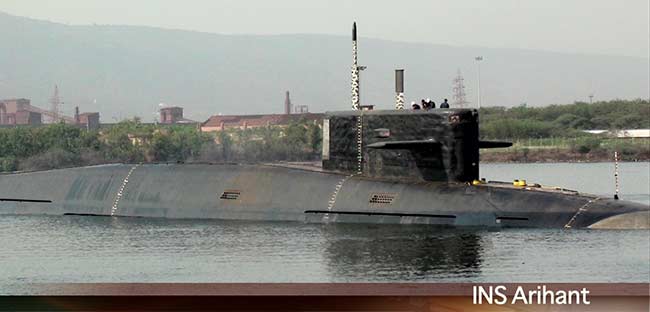

INS Arihant was introduced to the public on 26 July 2009 at a symbolic launch ceremony by Prime Minister Manmohan Singh's wife Gursharan Kaur.
#INDIA NUCLEAR SUBMARINE FULL#
The reactor's power was raised in increments of 5 to 10% until it reached full power. On 10 August 2013, the nuclear reactor of the submarine went critical this after several months of system checks using shore-based high-pressure steam. On 27 January 2013, Sagarika, the primary armament of Arihant, completed its final developmental test and was later integrated with the submarine. Īdmiral Verma told reporters on 7 August 2012 that sea trials of Arihant were commencing in coming months, and she was steadily progressing towards operationalisation. It was also expected that building the reactor, integration of systems, and sea trials would take three to five years. Development phases Ī nuclear scientist familiar with the project, on the condition of anonymity, echoed this report in response to media reports that India had successfully launched a completed nuclear submarine. The K-4 has a longer range of 3,500 km (2,200 mi), and had commenced trials in 2014. Russia was also reported to have provided assistance to Bhabha Atomic Research Centre (BARC) scientists in miniaturising the reactor to fit into the hull of the nuclear submarine Armament Īrihant has four vertical launch tubes, which can carry 12 (three per launch tube) smaller K-15 missiles or four larger K-4 missiles. The systems for the steam turbine integrated with the reactor were supplied by Walchandnagar Industries. Tata Power Strategic Engineering Division (SED) built the control systems for the submarine. The hull for the vessel was built by L&T's Hazira shipbuilding facility. It was reported that an 80 MW nuclear reactor was integrated into the hull of the ATV in January 2008. Successful operation for three years yielded the data that enabled the production version for Arihant. A land-based prototype of the reactor was first built at Kalpakkam and made operational in September 2006.

The vessel is powered by an 83 MW pressurised light-water reactor with enriched uranium fuel. Arihant is intended to be more of "a technology demonstrator" than a fully operational SSBN according to Admiral Nirmal Verma.

Their crew were to have the opportunity to train on INS Chakra, an Akula-class submarine, which the Indian Navy leased from Russia. The Arihant class submarines are reported to be based on the Akula-class submarine. The ATV project was set up in 1984, under Vice Admiral Mihir K. INS Arihant is the first of the planned five in the class of submarines designed and constructed as a part of the Indian Navy's secretive Advanced Technology Vessel (ATV) project. After fitting out and extensive sea trials, on 23 February 2016, she was confirmed as ready for operations, commissioned in August 2016, and deployed operationally in 2018. Īrihant was launched on 26 July 2009, the anniversary of Vijay Diwas ( Kargil War Victory Day) by Prime Minister Manmohan Singh. The 6,000 tonne vessel was built under the Advanced Technology Vessel (ATV) project at the Ship Building Centre in the port city of Visakhapatnam. INS Arihant (SSBN 80) ( Sanskrit: Vanquisher of Enemies), designated S2 Strategic Strike Nuclear Submarine, is the lead ship of India's Arihant class of nuclear-powered ballistic missile submarines. DRDO Panchendriya unified submarine sonar, control system and underwater communication system.



 0 kommentar(er)
0 kommentar(er)
